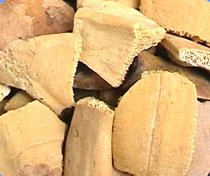Gui Ban

  | Gui Ban in TCM:Explore the properties of Gui Ban according to Chinese
Nutrition and Traditional Chinese Medicine (TCM):
Factoids:
English Name: testudinis shell (ventral side), tortoise plastron
Pharmacuetical Name: Plastrum Testudinis
Properties: salty, sweet, cold
Temperature: cold
Channels: HT, KD, LV
Flavors: sweet, salty
Tonifies: blood, yin
Special Properties:
disperses wind, stops bleeding, clears deficent heat
Alternate Forms:
- sheng- to nourish yin and anchor yang
- cu zhi- to benefit the KD, cool blood, nourish blood
Actions / Indications:
- Nourishes yin; anchors yang (dizziness, vertigo,
yin deficiency and yang rising with night sweats,tinnitus, steaming
bone disorder; internal wind due to yin deficiency with facial spasms
and tremors of the hands and feet)
- Tonifies KD; Strengthens Bones (soreness and weakness
of low back and legs, slow skeletal development in childre, or failure
of fontanel to close)
- Cools blood; stops uterine bleeding (excessive menstruation
or uterine bleeding due to yin deficiency and deficient heat)
- Nourishes blood; tonifies HT (palpitations, HT yin
and blood deficiency with anxiety, forgetfulness, insomnia)
Special Notes:
- (cooking: CRUSH and cook 30 minutes prior to adding other ingredients)
- Compare to Bie Jia
- Originally only the ventral side was used, but today both ventral and dorsal sides of the shell are used.
Contraindications: - (cc: damp-cold ST or diarrhea due to cold)
Disclaimer: In accordance with our terms of service, by using this web site you agree that none of the information found on this web site constitutes medical advice. You should always consult your doctor before trying any particular food or herbal remedy to treat disease.
Folk remedies presented on this site are designed to address specifc TCM diagnoses, and are not one-size-fits-all. If you would like to learn more about Traditional Chinese Medicine (TCM) and how it relates to Chinese Nutrition, you can book in a free call with a licensed professional. There is no obligation to purchase.
[CLICK HERE for your free INITIAL CONSULTATION] |

